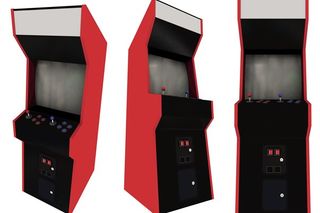Changing roms
Learn how to marry the majesty of your PC to classic games by emulating
In ancient times: proto-videogaming
Early home consoles and arcade games - at resolutions that would give their original developers heart attacks
Arcade
MAME (Multiple Arcade Machine Emulator) is a massive, sprawling monster compared to any other emulator in this feature. At the time of writing, this program supports over 3,000 games and, with new releases every month, that’s only going to grow. Its approach is one of total purity, attempting to emulate arcade games with pixel-perfect accuracy. It has an omnivore approach to games so in theory modern titles are supported too, though they’ll play like a dog unless you can bring back a processor from the future.
Get it working
1) There are roughly 800 million versions of MAME, but the most Windows- and n00b-friendly is MAME32. It takes a Windows Explorer approach to ROMs - just stick any you have into its “roms” subfolder and they’ll all show up under the “available” tab on MAME32’s main screen. You can right-click on each one and select “properties” to create individual settings.
2) You can double click on any game to launch it right away. After a brief copyright warning screen (at which you have to type “OK” on the first run, presuming you own the ROM. Ahem), you’re in. The default MAME32 buttons have 5 and 6 for adding credits and 1 and 2 for starting play, for use by - you guessed it - players one and two.
3) Pressing Tab in any game will bring up the config screen - choose “Input- General” to change keybindings for all games, or “Input- this game” to make alterations for this game only and no other. MAME32's clever like that. Not all games share the same default controls, so it’s worth checking with any newly added ROM anyway.
4) There are more settings to tinker with under the Options - Default Options menu in the main MAME32 interface, but there’s nothing mandatory in there. What’s worth doing if you get a big archive of ROMs, though, is to right-click preferred ones and click “add to favorites” - they’ll then show up in the custom-favorites folder.
Sign up to the 12DOVE Newsletter
Weekly digests, tales from the communities you love, and more
In ancient times: proto-videogaming
Early home consoles and arcade games - at resolutions that would give their original developers heart attacks
Arcade
MAME (Multiple Arcade Machine Emulator) is a massive, sprawling monster compared to any other emulator in this feature. At the time of writing, this program supports over 3,000 games and, with new releases every month, that’s only going to grow. Its approach is one of total purity, attempting to emulate arcade games with pixel-perfect accuracy. It has an omnivore approach to games so in theory modern titles are supported too, though they’ll play like a dog unless you can bring back a processor from the future.
Get it working
1) There are roughly 800 million versions of MAME, but the most Windows- and n00b-friendly is MAME32. It takes a Windows Explorer approach to ROMs - just stick any you have into its “roms” subfolder and they’ll all show up under the “available” tab on MAME32’s main screen. You can right-click on each one and select “properties” to create individual settings.
2) You can double click on any game to launch it right away. After a brief copyright warning screen (at which you have to type “OK” on the first run, presuming you own the ROM. Ahem), you’re in. The default MAME32 buttons have 5 and 6 for adding credits and 1 and 2 for starting play, for use by - you guessed it - players one and two.
3) Pressing Tab in any game will bring up the config screen - choose “Input- General” to change keybindings for all games, or “Input- this game” to make alterations for this game only and no other. MAME32's clever like that. Not all games share the same default controls, so it’s worth checking with any newly added ROM anyway.
4) There are more settings to tinker with under the Options - Default Options menu in the main MAME32 interface, but there’s nothing mandatory in there. What’s worth doing if you get a big archive of ROMs, though, is to right-click preferred ones and click “add to favorites” - they’ll then show up in the custom-favorites folder.

Above: 'Member these?
Essential games
1942
Or 1941, or 1943 - whichever version you prefer. This was one of the earliest, best-loved vertical shooters, and though it seems incredibly simplistic compared to, say, Ikaruga (see the Dreamcast section), it remains compelling and challenging. It also has a refreshingly cavalier attitude towards historical accuracy.
Robotron
The dual-stick control (one to move, the other to shoot, requiring a truly multi-tasking brain) is a mechanic that never really ages - from Smash TV to Geometry Wars, it just keeps on coming back. This was its strongest parent, and it’s still bastard-hard.
Golden Axe
One of the definitive keep-shoveling-in-coins side-scrolling beat-’em-ups, there’s an enduring idiocy to this. Unleashing a full-potion special attack, kidnapping a fire-breathing lizard mount or kicking the snot out of a thieving imp remains a heartwarming joy.
Street Fighter II:Champion Edition
Also available in SNES or Genesis flavors, but the arcade version of the expanded Champion revision of SF2 feels the most authentic. There’re about a dozen different cloned/hacked spin-offs, but you’ll need the original 4Mb “world” for any of them to load.
Most Popular




